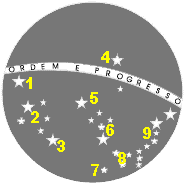Flag of Brazil
File:Brazil flag large.png
Flag ratio: 10:17
The modern Republican Brazilian flag was officially adopted on November 19, 1889. The concept was the work of Raimundo Teixeira Mendes, with the collaboration of Miguel Lemos and Manuel Pereira Reis. The design was executed by Décio Vilares. There was a previous flag designed by the Republicans but it was almost never used except November 15-19 1889:
File:Brazil-temp-flag.jpg
The temporary Republican Brazilian Flag, November 15 -19 1889.
The actual Brazilian flag is inspired by the previous Imperial Brazilian Flag:
File:Brazil-imperial-flag.jpg
The Imperial Flag, September 18 1822 - November 15 1889
It is a green flag with a large yellow rhombus in the center. Within the rhombus there is a blue circle, with white stars of five different sizes and a white band running through it. The motto "Ordem e Progresso" is inscribed in the band.
Symbology
It is often said that Brazil's national colors (green and yellow) represent the country's natural richness. Green would represent the exuberant forests of the Amazon Rainforest, the Atlantic Jungle and the Pantanal, while the yellow rhombus would represent the country's gold reserves: Brazil had once the largest gold mines in world and, between 1500 to 1900, more gold was extracted from Brazilian territory than had previously existed in the whole world.
Brazil's current flag was inspired by the flag of the former Brazilian Empire. On the imperial flag, the green represents the Bragança Royal Family of Pedro I, the first Emperor of Brazil; and the yellow represents the Castela e Lorena Royal Family of Leopoldina, Pedro's wife.
In the centre the old imperial flag bore Royal Coat of Arms. On the modern republican flag that has been replaced by the blue circle, which is a depiction of the sky over Rio de Janeiro on the morning of November 15, 1889 – the day the Republic of Brazil was declared. It is shown as seen from outside of the celestial sphere (i.e. the view is mirrored). Each of the 27 stars represents a different state and the Federal District. The number of stars changes within the creation of new states and, since the founding of the republic, has risen from 21 stars.
The star that represents the Federal District is Sigma Octantis, and its position near the south celestial pole makes it visible across almost the whole country, year round. Also, given its polar position, all the other stars depicted on the flag trace appear to rotate around Octans. Choosing this star to represent Brazil's capital is thus particularly apt.
The motto "Ordem e Progresso" (Order and Progress) is inspired by Auguste Comte's motto of positivism: "L'amour pour principe et l'ordre pour base; le progrès pour but" ("Love the Principle and Order the Basis; Progress the Aim").
The current national flag and ensign of Brazil were adopted on May 12, 1992 (Law number 8.421 May 11, 1992).
The Stars
The constellation of southern cross is on meridian (indicated by the number 6 in the diagram). To the south of it, is the Polaris Australis (σ Octantis, numbered 7), representing the Federal District.
A list of constellations and stars on the map:
- Procyon (α Canis Minoris),
- Canis Major, with the largest star depicting Sirius,
- Canopus (α Carinae),
- Spica (α Virginis)
- Hydra
- Crux
- Polaris Australis
- Triangulum Australe
- Scorpius
Each star represents a Brazilian State (except Sigma Octantis which represents the Capital): File:Brasil-flag-stars.jpg
| STATE | STAR | CONSTELATION | SIZE |
| Amazonas | Alpha Canis Minoris (Procyon) | Canis Minor, the Lesser Dog | 1 |
| Mato Grosso | Alpha Canis Majoris (Sirius) | Canis Major, the Greater Dog | 1 |
| Amapá | Beta Canis Majoris (Mirzam) | Canis Major, the Greater Dog | 3 |
| Rondônia | Gamma Canis Majoris (Muliphen) | Canis Major, the Greater Dog | |
| Roraima | Delta Canis Majoris (Wezen) | Canis Major, the Greater Dog | 2 |
| Tocantins | Epsilon Canis Majoris (Adhara) | Canis Major, the Greater Dog | 2 |
| Pará | Alpha Virginis (Spica) | Virgo, the Virgin | 1 |
| Piauí | Alpha Scorpii (Antares) | Scorpius, the Scorpion | 1 |
| Maranhão | Beta Scorpii (Graffias) | Scorpius, the Scorpion | 3 |
| Ceará | Epsilon Scorpii | Scorpius, the Scorpion | 2 |
| Alagoas | Theta Scorpii (Sargas) | Scorpius, the Scorpion | 2 |
| Sergipe | Iota Scorpii | Scorpius, the Scorpion | 3 |
| Paraíba | Kappa Scorpii | Scorpius, the Scorpion | 3 |
| Rio Grande do Norte | Lambda Scorpii (Shaula) | Scorpius, the Scorpion | 2 |
| Pernambuco | Mu Scorpii | Scorpius, the Scorpion | 3 |
| Mato Grosso do Sul | Alpha Hydrae (Alphard) | Hydra, the Water Serpent | 2 |
| Acre | Gamma Hydrae | Hydra, the Water Serpent | 3 |
| São Paulo | Alpha Crucis (Acrux) | Crux, the Southern Cross | 1 |
| Rio de Janeiro | Beta Crucis (Becrux) | Crux, the Southern Cross | 2 |
| Bahia | Gamma Crucis (Gacrux) | Crux, the Southern Cross | 2 |
| Minas Gerais | Delta Crucis | Crux, the Southern Cross | 3 |
| Espírito Santo | Epsilon Crucis | Crux, the Southern Cross | 4 |
| Rio Grande do Sul | Alpha Trianguli Australe | Triangulum Australe, the Southern Triangle | 2 |
| Santa Catarina | Beta Trianguli Australe | Triangulum Australe, the Southern Triangle | 3 |
| Paraná | Gamma Trianguli Australe | Triangulum Australe, the Southern Triangle | 3 |
| Goiás | Alpha Carinae (Canopus) | Carina, the Keel of Argo | |
| CAPITAL | STAR | CONSTELATION | SIZE |
| Brasília DF | Sigma Octantis (Polaris Australis) | Octans, the Octant | 5 |

